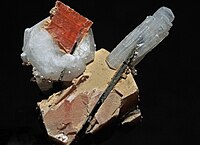
Photo from wikipedia
Recently, there has been intense interest in pure organic room-temperature phosphorescence (ORTP) from cocrystals composed of 1,4-diiodotetrafluorobenzene (DITFB) and a variety of polyaromatic hydrocarbons (PAHs) or their derivatives. To expand… Click to show full abstract
Recently, there has been intense interest in pure organic room-temperature phosphorescence (ORTP) from cocrystals composed of 1,4-diiodotetrafluorobenzene (DITFB) and a variety of polyaromatic hydrocarbons (PAHs) or their derivatives. To expand the possibility of halogen bonding-based cocrystals, we investigate the relationship between the crystal packing motifs and ORTP characteristics in binary cocrystals composed of DITFB and PAHs of phenanthrene (Phen), chrysene (Chry), and pyrene (Pyr), respectively. The σ-hole···π and π-hole···π interactions determine not only the crystal packing motifs but also photoluminescence quantum yields (PLQYs). The Phen-DITFB and Chry-DITFB binary cocrystals with σ-hole···π interactions show higher PLQY compared with that of the Pyr-DITFB binary cocrystal with π-hole···π interaction. Further, to clarify the effect of crystal structures on PLQY, ternary cocrystals are prepared by partially doping Pyr into Phen-DITFB. The backbone of the crystal packing motif of the ternary cocrystal originates from a Phen-DITFB cocrystal with σ-hole···π interaction, and some of the Phen sites are randomly replaced with Pyr molecules. The ORTP emission is derived from Pyr. The maximum PLQY is more than 20% due to suppressing nonradiative decay by changing the crystal packing motif. This article is protected by copyright. All rights reserved.
Journal Title: Advanced materials
Year Published: 2023
Link to full text (if available)
Share on Social Media: Sign Up to like & get
recommendations!